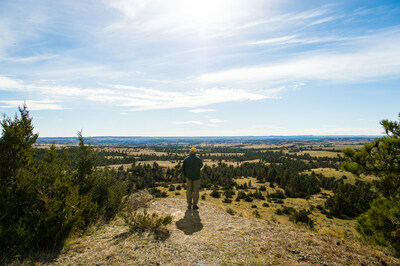Subjects: NPT, PDT, RCY, PET, ENI, NAT
5 Ways to Help Nature and Communities Cope With Climate Threats
By Jennifer Browning
Senior director, The Pew Charitable Trusts'áU.S. conservation project
WASHINGTON, April 19, 2024 /PRNewswire/ -- The United States is one of 17 nations that scientists callámegadiverse?places that harbor the majority of Earth's plant and animal species, along with high numbers of species found nowhere else.
Yet, in the U.S. many of these plants and animals face multiple threats, including from a changing climate that can damage habitats and ecosystems. To protect these special places, conservation choices made today, such as what areas to protect and how to care for them, also should account for the expected future conditions.
Human communities feel these impacts?from harm to livelihoods and damage to homes and property to strained state and federal finances.
To help people better withstand the changes, communities and governments are beginning to consider future conditions, such as increased rainfall, more intense storms, or wildfires, when updating or planning new infrastructure projects. They also are incorporating natural solutions, such as protecting and restoring wetlands to minimize flooding from severe storms and sea level rise.
Updated science shows that holistic conservation approaches are more effective than focusing on a single river, wetland, forest, or species. Experts increasingly favor this more comprehensive view because ecosystems are interconnected and managing them in an integrated way benefits biodiversity and people?for example, by helping keep the air and water clean.
In the U.S., these five approaches can help address climate change and declining biodiversity.
1. Protect ecosystems
According to the International Union for Conservation of Nature, large protected areas, such as reserves or parks, are important lines of defense in combating climate change and biodiversity loss simultaneously. If effectively managed, such areas can safeguard nature and cultural resources, protect human health and well-being, and contribute to sustainable livelihoods.
2. Conserve, restore, and connect fish and wildlife habitats
Throughout the U.S., many fish and wildlife pathways and migratory routes have been obstructed by roadways, dams, culverts, and other infrastructure. Eliminating or retrofitting some of those barriers or building new crossings for fish and wildlife helps those species travel and access food.
3. Help nature withstand changing conditions
State and federal agencies responsible for overseeing public landscapes are often required to develop management plans for effective stewardship. Climate-ready management plans can anticipate and address climate change impacts on ecosystems by using science and local and traditional Indigenous knowledge to assess predicted changes, such as warming, sea-level rise, or increased wildfire risk.
4. Prepare communities for climate impacts
Protecting communities from natural disasters and other climate change effects demands collaboration among all government levels and an engaged, informed public. Butáresilience planningáto prepare for floods, wildfires, or sea-level rise is somewhat new for states. A stateáresilience planácan help leaders anticipate future conditions, lay out strategies to adapt, and target resources to socially vulnerable communities and those most exposed to climate risk.
5. Capture carbon in nature
While countering climate change requires immediate and sustained reductions in greenhouse gas emissions, additional gains can be made by protecting ecosystems that remove greenhouse gases from the atmosphere and store them. Healthy freshwater and coastal wetlands?including peatlands, mangroves, seagrasses, and salt marshes?can store more carbonáper acre than any habitat on Earth. These places also buffer communities from sea-level rise, floods, and fires; improve air and water quality; provide wildlife habitat; and support cultural resources.
Preparing people and nature for drought, wildfire, flooding, and sea-level rise and protecting biodiversity hinge on partnerships and collaboration among government, communities, businesses, and others. Through planning smartly, sharing ideas, and coordinating efforts, policymakers, stakeholders, and rights holders can halt the decline of species and build adaptable and resilient communities.
For more information, visit U.S. Conservation | The Pew Charitable Trusts (pewtrusts.org)
Contact: Debbie Salamone, senior communications officer, [email protected] 407.982.0958
SOURCE The Pew Charitable Trusts
These press releases may also interest you
|
News published on and distributed by:





